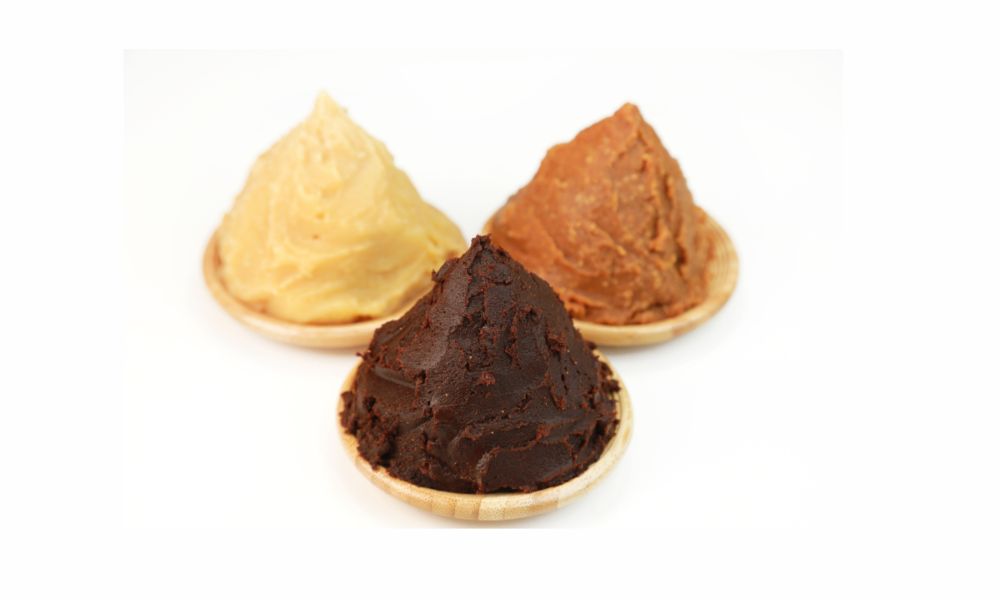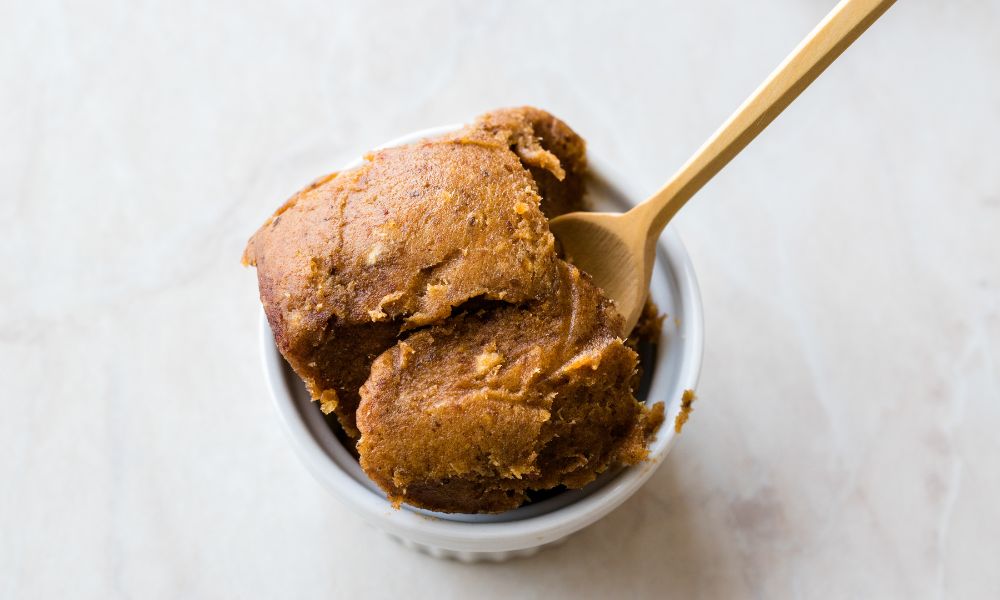Hey there, miso enthusiasts! Are you always wondering, “how long does miso paste last in the fridge?” You’re in luck, as we’re about to dive into the ins and outs of miso paste storage, its shelf life, and how to make sure it stays fresh for as long as possible.
So, without further ado, let’s unravel the mysteries of miso paste!

How Long Does Miso Paste Last in the Fridge?
Unopened miso paste
An unopened container of miso paste can last up to a year in the refrigerator, even a few months after the expiration date, provided it is stored in a cool, dark place. The fermentation process, which is crucial to creating miso paste, acts as a natural preservative, contributing to its extended shelf life.
Opened miso paste
Once opened, miso paste can last between six months and a year in the refrigerator, depending on the type of miso and how it’s stored. Proper storage techniques, which we’ll discuss later in this article, are essential to preserving the quality and flavor of your miso paste.
Factors affecting shelf life
Type of miso: Different types of miso paste have varying shelf lives due to their unique fermentation processes and ingredient compositions. Generally, lighter miso pastes (such as white or yellow miso) have shorter shelf lives than darker miso pastes (like red miso).
Preservation methods: Using a clean spoon when scooping miso paste, sealing the container tightly, and storing it in the refrigerator can help extend its shelf life.
Understanding Miso Paste
| Type | Name | Flavor Profile | Perfect For | How It’s Made | Key Ingredients |
|---|---|---|---|---|---|
| White Miso | Shiro | Mild, slightly sweet | Light soups, dressings, sauces | Fermented mixture of soybeans, rice, salt, and koji | Soybeans, rice, salt, koji |
| Yellow Miso | Shinshu | Balanced, moderately strong | Variety of dishes, including soups and marinades | Fermented mixture of soybeans, barley or rice, salt, and koji | Soybeans, barley or rice, salt, koji |
| Red Miso | Aka | Robust, salty, deep flavor | Hearty soups, stews, marinades | Fermented mixture of soybeans, higher proportion of barley or rice, salt, and koji | Soybeans, barley or rice, salt, koji |
White miso (shiro): This mild, slightly sweet miso paste is made from soybeans and rice. It’s perfect for light soups, dressings, and sauces.
Yellow miso (shinshu): Made from soybeans and barley or rice, yellow miso has a slightly stronger flavor than white miso and works well in a variety of dishes.
Red miso (aka): This robust, salty miso paste is made from soybeans and a higher proportion of barley or rice, giving it a deeper color and flavor. It’s ideal for hearty soups, stews, and marinades.
How miso paste is made

Fermentation process: Miso paste is created by fermenting a mixture of soybeans, grains (such as rice or barley), salt, and a mold culture called koji. The fermentation process can take anywhere from a few weeks to several years, depending on the desired flavor and texture.
Key ingredients: Soybeans, grains, salt, and koji are the primary ingredients in miso paste, with each contributing to its unique taste and nutritional profile.
Proper Storage Techniques
Refrigerator storage
Optimal temperature: Miso paste should be stored in the refrigerator at a temperature between 34°F and 40°F (1°C to 4°C) to maintain its freshness.
Suitable containers: Use airtight containers or resealable plastic bags to store miso paste, ensuring that it’s protected from air and moisture.
Freezer storage
Preparing miso paste for freezing: You can freeze miso paste in small, portion-sized containers or ice cube trays for easy access and thawing.
Thawing and using frozen miso paste: Thaw
frozen miso paste in the refrigerator or at room temperature. Use thawed miso paste within a few days for optimal flavor and texture.
Signs of Spoilage

Color changes
Miso paste that has gone bad may exhibit changes in color, such as darkening or developing mold. Discard any miso paste with visible mold or significant color changes.
Texture changes
Spoiled miso paste may become slimy, watery, or have an unusual consistency. If you notice any of these changes, it’s best to discard the miso paste.
Odor changes
An off or sour smell is another sign that your miso paste has spoiled. If the miso paste smells unpleasant, it’s time to throw it out and replace it with a fresh batch.
Maximizing Miso Paste Quality
Tips for maintaining freshness
- Always use a clean spoon when scooping miso paste.
- Keep the miso paste container tightly sealed.
- Store miso paste in the refrigerator or freezer.
Using miso paste in recipes
- Soups and broths: Miso paste is a classic ingredient in miso soup, adding depth and umami to the broth.
- Marinades and glazes: Use miso paste to create flavorful marinades for meats, fish, and vegetables.
- Salad dressings: Mix miso paste with oil, vinegar, and other seasonings for a unique and savory salad dressing.
Health Benefits of Miso Paste
Nutritional profile
Here’s a text table showcasing the nutritional profile of miso paste per 1 tablespoon (18 grams) serving:
| Nutrient | Amount | % Daily Value |
|---|---|---|
| Calories | 34 kcal | – |
| Total Fat | 1 g | 1% |
| Saturated Fat | 0.2 g | 1% |
| Sodium | 634 mg | 28% |
| Total Carbohydrate | 4.7 g | 2% |
| Dietary Fiber | 1 g | 4% |
| Sugars | 0.7 g | – |
| Protein | 2 g | 4% |
| Vitamin K | 3.3 mcg | 4% |
| Riboflavin (Vitamin B2) | 0.1 mg | 6% |
| Niacin (Vitamin B3) | 0.9 mg | 4% |
| Manganese | 0.1 mg | 5% |
Miso paste is a good source of protein, vitamins, and minerals, such as vitamin K, B vitamins, and manganese. It’s also low in calories and fat, making it a healthy addition to your diet.
Probiotics and gut health
Fermented foods like miso paste contain beneficial probiotics that support gut health and digestion.
Antioxidant properties
Miso paste is rich in antioxidants, which help protect your body from free radicals and oxidative stress.
Miso Paste Alternatives
Substitutes for miso paste in recipes
If you don’t have miso paste on hand, you can use alternatives such as soy sauce, tahini, or a combination of these with other ingredients to mimic miso paste’s flavor and texture.
How to make your own miso paste
Making miso paste at home is possible, but it requires time, patience, and access to the key ingredients, such as soybeans, grains, salt, and koji.
Summary
Miso paste is a versatile, flavorful ingredient with a long shelf life when stored properly. Unopened miso paste can last up to a year in the refrigerator, while opened miso paste can last between six months and a year. Proper storage techniques, such as refrigeration and using airtight containers, are essential to maintaining miso paste’s quality and freshness. Miso paste is not only delicious but also offers numerous health benefits, making it a valuable addition to your pantry.
FAQs
What is miso paste?
Miso paste is a traditional Japanese condiment made from fermented soybeans, grains (like rice or barley), salt, and a mold culture called koji. It’s commonly used in soups, sauces, dressings, and marinades to add a savory, umami flavor.
How long does miso paste last in the fridge?
Unopened miso paste can last up to a year in the refrigerator, while opened miso paste can last between six months and a year, depending on the type of miso and proper storage techniques.
Can I freeze miso paste?
Yes, you can freeze miso paste in small, portion-sized containers or ice cube trays for easy access and thawing. Thaw frozen miso paste in the refrigerator or at room temperature, and use it within a few days for optimal flavor and texture.
How can I tell if my miso paste has gone bad?
Signs of spoiled miso paste include changes in color (darkening or mold growth), texture (sliminess, watery consistency), and odor (off or sour smell). If you notice any of these signs, it’s best to discard the miso paste.
What are the health benefits of miso paste?
Miso paste is a good source of protein, vitamins, and minerals. It’s low in calories and fat, and contains beneficial probiotics that support gut health and digestion. Miso paste is also rich in antioxidants, which help protect your body from free radicals and oxidative stress.
What are the different types of miso paste?
There are several types of miso paste, including white miso (shiro), yellow miso (shinshu), and red miso (aka). Each type has a unique flavor profile and is suitable for different dishes.
Can I use a substitute for miso paste in recipes?
If you don’t have miso paste on hand, you can use alternatives such as soy sauce, tahini, or a combination of these with other ingredients to mimic miso paste’s flavor and texture in your recipes.
How can I make my own miso paste?
Making miso paste at home is possible, but it requires time, patience, and access to key ingredients like soybeans, grains, salt, and koji. The process involves fermenting a mixture of these ingredients for an extended period, resulting in a unique flavor and texture.